In the News: Borders & Beyond
A roundup of recent religion writing

(John Moore/Getty Images)
‘I wanted to stop her crying’: The image of a migrant child that broke a photographer’s heart
So much is happening, and so much of it is extremely important. Keeping up, understanding what’s going on, looking for smart analysis, it’s overwhelming. And yet, there is just nowhere else to start, we have to talk — and do something — about our government criminalizing and detaining thousands of people migrating to the US.
First, as evidenced above, this is yet another crucial moment for documentary photography. If you are a photographer whose work is about religion and migration, we strongly encourage you to apply for a new grant from the Magnum Foundation.
We have had the pleasure of collaborating with the Magnum Foundation in the past (our special issue of work on religion was published this time last year) and of working with them on the new Photography in Collaboration: Migration and Religion Request for Proposals along with Laura McTighe.
Magnum Foundation is accepting proposals for Photography in Collaboration: Migration and Religion, an initiative for photographers to expand upon their practice by working with creative partners from other disciplines. We will support up to five projects that further understanding of the politically significant and vastly complex intersections of migration and religion. Selected projects will receive project development support and production grants of up to $25,000.
Second, Listen to Children Who’ve Just Been Separated From Their Parents at the Border reported by Ginger Thompson at ProPublica
An audio recording obtained by ProPublica adds real-life sounds of suffering to a contentious policy debate that has so far been short on input from those with the most at stake: immigrant children. More than 2,300 of them have been separated from their parents since April, when the Trump administration launched its “zero tolerance” immigration policy, which calls for prosecuting all people who attempt to illegally enter the country and taking away the children they brought with them. More than 100 of those children are under the age of 4. The children are initially held in warehouses, tents or big box stores that have been converted into Border Patrol detention facilities.
After which, I recommend watching Becca Heller, director of the International Refugee Assistance Project, discusses her efforts to fight President Trump’s aggressive crackdown on immigrants and asylum seekers on The Daily Show with Trevor Noah
And then reading Dahlia Lithwick‘s It’s All Too Much, and We Still Have to Care for Slate
That we are finding ourselves unable to process or act or organize because the large-scale daily horrors are escalating and the news is overpowering is perfectly understandable. But we need to understand that and acknowledge it and then refuse it any purchase. Because to be overwhelmed and to do nothing are a choice.
Lithwick and Margo Schlanger also put together this guide: Here’s How You Can Help Fight Family Separation at the Border for Slate
Meanwhile Sessions cites Bible passage to defend slavery in defense of separating immigrant families by Julie Zauzmer and Keith McMillan for The Washington Post
“There are two dominant places in American history when Romans 13 is invoked,” said John Fea, a professor of American history at Messiah College in Pennsylvania. “One is during the American Revolution [when] it was invoked by loyalists, those who opposed the American Revolution.”
The other, Fea said, “is in the 1840s and 1850s, when Romans 13 is invoked by defenders of the South or defenders of slavery to ward off abolitionists who believed that slavery is wrong. I mean, this is the same argument that Southern slaveholders and the advocates of a Southern way of life made.
From an actual authority on the matter, Father James Martin: Separating kids from their parents is not biblical. Period.
Jesuit Priest and editor-at-large of “America” Magazine, Father James Martin, says that the use of the bible by some White House officials to defend the separation of parents and children at the border is “reprehensible”.
And Lincoln Mullen took a further look at The Fight to Define Romans 13 for The Atlantic
Where does Jeff Sessions fit in this brief history of Romans 13? Sessions, like so many other Americans throughout history, thinks he has the Bible on his side. The verses Sessions chose to cite, and the interpretation that he has given them, is part of the broader Trump administration strategy of playing to the fears and identities of American evangelicals, who have been bringing Romans 13 back into public discourse since the rise of law-and-order politics and the Christian Right. But the Bible is a text less often read than read into. As many of his “church friends” persist in pointing out, Sessions did not cite the verse later in Romans 13 where Paul writes that God’s laws “are summed up in this word, ‘Love your neighbor as yourself,’” with the word “neighbor” echoing both parable of the Good Samaritan and the countless verses in the Law and the Prophets on treating the stranger and the immigrant with mercy. Sessions may claim the Bible’s contested authority, but what the attorney general actually has on his side is the thread of American history that justifies oppression and domination in the name of law and order.
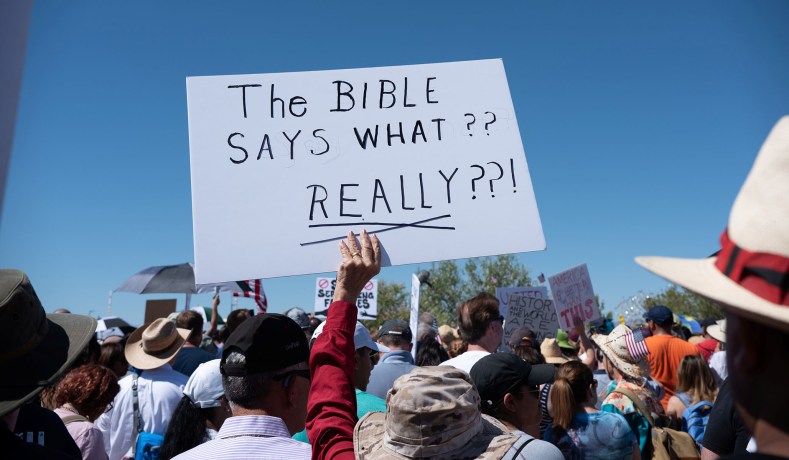
A protest against a recent U.S. immigration policy of separating children from their families. Outside the Tornillo Tranit Centre, in Tornillo, Texas, U.S. June 17, 2018 (REUTERS/Monica Lozano)
Let’s all start planning how we, too, can “act a WHOLE DONKEY”: This Woman Had the Perfect Response When Border Patrol Boarded Her Greyhound Bus from Yvette Montoya for Hip Latina
The agents get on. Proceed to announce that they are about to start asking for “documentation” from people.
I Stand up and yell “I’m not showing you shit! I’m not driving this bus, so you have NO RIGHT to ask me for anything! And the rest of you guys don’t have to show them anything, either! This is harassment and racial profiling! Don’t show them a gotdamn thing! We are not within 100 miles of a border so they have NO LEGAL RIGHT or jurisdiction here! GOOGLE IT!”
The agents start to look exasperated, because they can see I’m willing to act a WHOLE DONKEY. One of them said “Fine. We can see that you’re a citizen because of your filthy mouth”. And then they just said “go ahead” to the bus driver and got off.
And lastly, a reminder that this is not just happening here: Italian Minister Moves to Count and Expel Roma, Drawing Outrage report Elisabetter Povoledo and Gaia Pianigiani for The New York Times
He has compared the European Union to the Titanic, accused the left of supporting immigration to supply slave labor, and insulted migrants using any number of disparaging epithets. But Italy’s new interior minister, Matteo Salvini, went too far even for his allies this week when he announced that he would conduct a census of Roma people in Italy, a prelude to expelling those without valid residence permits.
“And Italian Roma? Unfortunately, we have to keep them,” Mr. Salvini said on Monday during an interview on a regional television station.
This weekend, while you’re protesting and donating and volunteering, maybe also take some time to watch “Coco” and then read Jia Tolentino‘s superb “Coco,” a Story About Borders and Love, Is a Definitive Movie for this Moment at The New Yorker
“Coco” is a movie about borders more than anything—the beauty in their porousness, the absolute pain produced when a border locks you away from your family. The conflict in the story comes from not being able to cross over; the resolution is that love pulls you through to the other side. The thesis of the movie is that families belong together. I watched it again this week, reading the news that Donald Trump is considering building an unregulated holding camp for migrant children, that ice showed up on the lawn of a legal permanent resident and initiated deportation procedures, that a four-month-old baby was torn away from her breast-feeding mother. If justice is what love looks like in public, then love has started to seem like the stuff of children’s movies, or maybe the stuff of this children’s movie—something that doesn’t make sense in the adult world, but should.
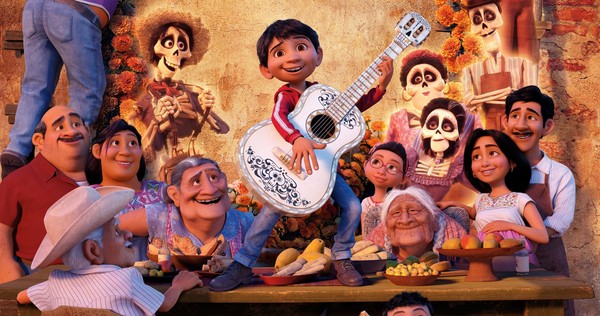
Coco
Anthony Bourdain loved Mexico (where “Coco” is set), and we, quite frankly, loved Anthony Bourdain and have been mourning him with these essays.
David Simon wrote a beautiful post about Bourdain on his blog The Audacity of Despair simply titled Tony
A lot of people will tell you that on meeting Tony – despite how extraordinary a being he was – they somehow felt as if they’d known him for years. In part, this was the natural result of having so much of his wit and intellect bleed across our television screens. But just as elemental, I believe, was the man’s almost unlimited capacity for empathy, for feeling the lives and loves and hopes of others. He listened as few listen. And when he spoke, it was often to deliver some precise personal recollection that was an echo or simile on what was still in his ear. He abhorred a non sequitur; for him, human communication — much like his core ideas about food and travel and being – was about finding the sacred middle between people.
Helen Rosner wrote about Anthony Bourdain and the Power of Telling the Truth for The New Yorker
Bourdain’s fame wasn’t the distant, lacquered type of an actor or a musician, bundled and sold with a life-style newsletter. Bourdain felt like your brother, your rad uncle, your impossibly cool dad—your realest, smartest friend, who wandered outside after beers at the local one night and ended up in front of some TV cameras and decided to stay there. As a writer himself, he was always looking out for other writers, always saying yes, always available for interviews and comments. You had to fight through a wall of skeptical P.R. to get to someone like Guy Fieri, but Bourdain was right there, for everyone, in equal measure. He remembered names. He took every question seriously. He was twenty minutes early to every appointment, to the minute. Every newspaper, every magazine, every Web site that asked got its Bourdain quotes—and good ones, too! Not pre-scripted pablum but potent missiles of cultural commentary—bombastic wisdom, grand pronouncements, eviscerations of celebrities, flagrantly named names.
And you can watch Bourdain visit “a magical spiritual place” in this clip, Anthony Bourdain tries the Waffle House
Meanwhile, for an example of the superficial, thoughtless, and offensive religion-as-metaphor writing hot take, you can read (or not) “The Cult of Anthony Bourdain” by Kyle Smith at The National Review. Just don’t do this. Any of this.
But, if you want to read about why we’re so into cults, do read Kirsin Allio asking Why Are We So Fascinated by Cults? in The Paris Review
Wild Wild Country is a classic retelling of the American myth, refracted and distorted but nonetheless there. We recognize all the big themes: the cant of individualism versus the chant of egalitarianism. There is manifest destiny, hubris, the dogged pursuit of religious freedom, land use, the ironies of the Second Amendment.
Right, so, back to US politics.
Arun Venugopal explores the question: The American Flag: Symbol of Beauty or Intimidation at WNYC
Nationalism isn’t unique to America, but the way it’s embodied in the flag is. Marc Leepson, author of “Flag: An American Biography,” said the feelings of near-religious adoration that many Americans have for the flag is unlike anything in the rest of the world.
Jeff Sharlet annotates the “Blue Lives Matter” flag in A Flag for Trump’s America: The Power of Strength at Harper’s
3. The Blue Lives Matter movement, which began after the December 20, 2014, slaying of two New York City police officers, soon adopted the Thin Blue Line flag. The murders were the catalyst for what quickly became a rebuttal to Black Lives Matter, its insistence that we pay more attention to killer cops than to cops killed in the line of duty. And the flag symbolized an even deeper sense of peril among its admirers, those who mix Thin Blue Line memes with messages about fighting the Islamic State, “illegals,” and socialism, the “chaos” represented by the black bars below the blue line. Those stripes also recall media reports on police violence, in part because the media itself is increasingly seen as an enemy of law and order. The blue line poses the old question of organized labor—which side are you on?—as a loyalty test. Loyalty to what? Authority. Authority for authority’s sake, as seen in personal variations of the flag that soon proliferated: a Christian cross bisecting its stripes, bullets instead of stars. The flag began to appear alongside the other standards of lovers of the strong hand: the yellow snake of “Don’t Tread on Me,” the Stars and Bars of the Confederacy, and even—most notably at the August 2017 Unite the Right protest in Charlottesville, Virginia—the swastika’s crooked cross.
And, in a magnificent example of subversive symbolism, a 26-Year-Old Wins Local Office in Georgia, Takes Her Oath of Office on Autobiography of Malcolm X reports Angela Helm for The Root. More photos are here.
Since Tuesday’s elections held throughout the nation, an already iconic photo has been sweeping the internet—of 26-year-old Mariah Parker taking her oath of office as Athens-Clarke County, Ga., commissioner for District 2, with her mother holding, not the Bible or Quran, but another good book: Alex Haley’s Autobiography of Malcolm X.
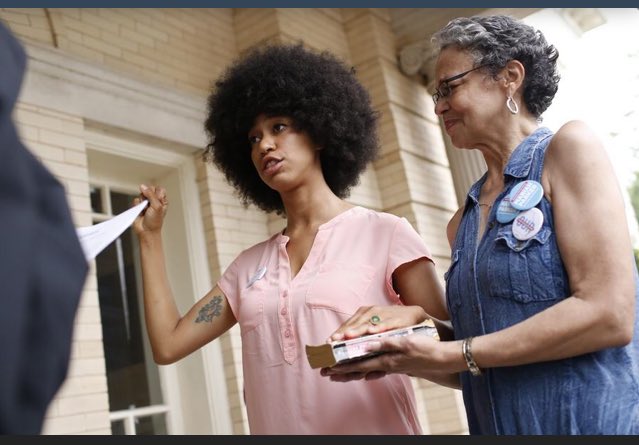
Mariah Parker takes her oath of office for County Commissioner District 2 with her hand on the autobiography of Malcolm X and her mother Mattie Parker by her side on the steps of City Hall in downtown Athens, Ga., Tuesday, June 5, 2018. Parker filled the county commissioner seat vacated by Harry Sims who left his seat to run for mayor. She won the election for District 2 by 13 votes. [Joshua L. Jones/Athens Banner-Herald]
Speaking of what people should, and should not, be able to do with bibles, there was the Masterpiece Cakeshop Supreme Court ruling. After which,Dahlia Lithwick‘s podcast Amicus was about Religious Belief, Sincerely Held: Examining the narrow slicing of the Masterpiece Cakeshop ruling and contemplating the role of faith in our laws
An epic Amicus this week, with a thorough analysis of Masterpiece Cakeshop v. Colorado Civil Rights Commission with Slate’s Mark Joseph Stern. What does is tell us about Justice Anthony Kennedy’s plans, and can it tell us anything about the travel ban case?
Then Dahlia Lithwick speaks with one of her heroes, the Rev. William Barber, about how progressives ceded the language of faith, morality, and the Constitution—and how they are reclaiming it.
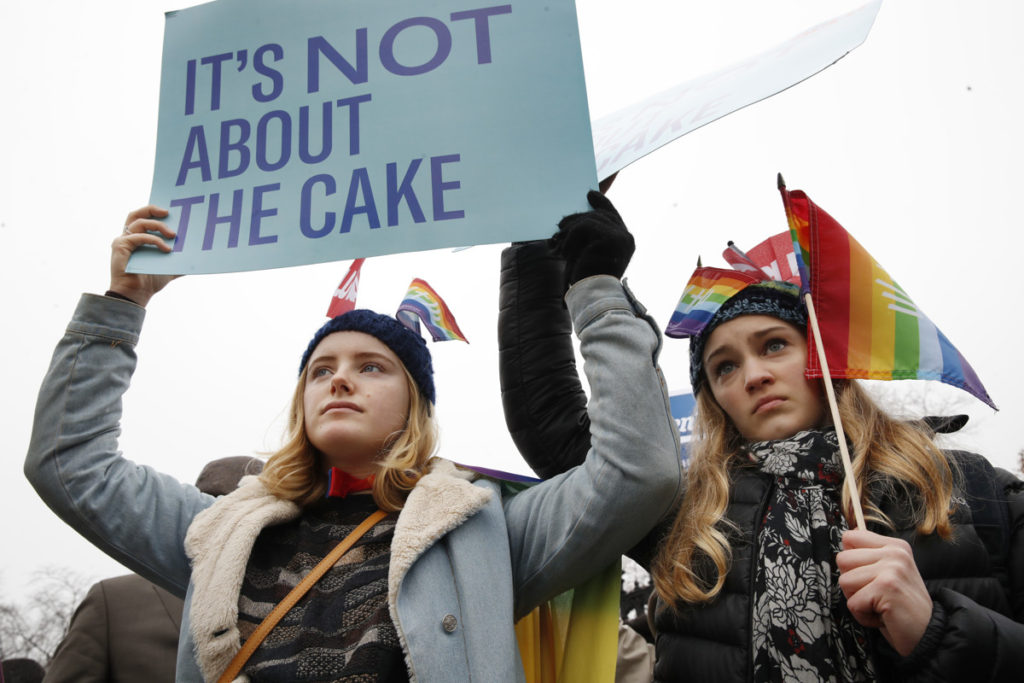
Lydia Macy, 17, left, and Mira Gottlieb, 16, both of Berkeley, Calif., rally outside of the Supreme Court which is hearing the ‘Masterpiece Cakeshop v. Colorado Civil Rights Commission’ today, Tuesday, Dec. 5, 2017, in Washington. (Jacquelyn Martin, AP)
Sarah Posner argued that The “Masterpiece Cakeshop” Decision Is Not As Harmless As You Think atThe Nation.
What will be the evidence of such supposed animus in the next case? A question from a judge at oral arguments? Deposition questions by government attorneys? That is the crucial open question from Masterpiece—not whether the next case will be more winnable for a gay couple without Masterpiece’s specific facts, but how hard opponents of LGBTQ rights will work to convince the courts that similar specific facts exist in that case, too.
Today, the Court did not foreclose LGBTQ people from suing under anti-discrimination laws. But it did open the door for ADF to use one of its favored tropes—that the government is hostile to religion—to continue to chip away at those protections. And there is really no telling how that will turn out.
And Winnifred Fallers Sullivan asked Is Masterpiece Cakeshop a church? in The Immanent Frame
Is the Masterpiece Cakeshop a church? It is a place where Mr. Phillips honors God. It is a place where Mr. Craig and Mr. Mullins sought to acquire a religious object. But these are not facts that the Court can notice. After disestablishment, law has no way of constitutionally locating religion. Over the last few decades, religion in law has been reduced to the attitudes of sincere persons described as devout about sex. By refusing to talk about religion beyond sex, law affirms the avoidance of serious public conversation about what God requires. In what public context today can one say back to Mr. Phillips that Jesus ate with sinners? Or that we are all sinners? Or “judge not that ye be not judged”? Or that hospitality and table fellowship have been virtues in many traditions? And listen to his response. If all we can do is isolate and segregate devout religious people and either vilify them or treat them with kid gloves, where will we be?
While Patrick Blanchfield and Suzanne Schneider were guests on Ashley Ford‘s show “112BK” to discuss some other major issues in American culture, Gun Violence & Masculinity
Also on the subject of guns and religion, Amr Alfiky brings us ‘Make Sure Not to Talk Any Arabic’: American Muslims and Their Guns in The New York Times
American Muslims like Ms. Muhammad say they own guns for the same reasons as anyone else: for protection, for hunting and sport shooting, for gun and rifle collections or for their work.
They also cite another factor: fear of persecution, at a time when hate crimes against Muslims have soared to their highest levels since the aftermath of the Sept. 11, 2001, attacks.
But owning a gun is no assurance of security. Muslim gun owners are viewed with suspicion by gun stores, ranges and clubs, and occasionally met with harassment.
While we’re on the subject of American Islam, Brittany Friedman and Zachary Sommers wrote about Solitary confinement and the Nation of Islam for The Immanent Frame
Our research is comprised of archival, ethnographic, and statistical data, though this essay solely discusses the archival and statistical data in abbreviated form. Focusing on California, a supreme example of American hyper incarceration, we compiled a state-specific database of public and private archival material (over seven hundred documents) that reveals the construction of black militants as so-called social problems and the consequences of this construction for the prison social system—mainly, the increased use of solitary confinement. We found in particular that the California Department of Corrections and Rehabilitation (CDCR) singled out the Nation of Islam as the first organization for systematic segregation from the general prisoner population. Our qualitative findings are supported by statistical analysis of a nationally representative survey, which reveals that correctional institutions with a Nation of Islam presence are almost fourteen times more likely to use solitary confinement.
Which brings us to more stories about race, racism, and the law.
First, A California church flirts with an unusual social experiment: to never call police again reports Jaweed Kaleem for the Los Angeles Times
They call it “divesting” from police. The church is part of a tiny but growing movement among liberal houses of worship around the nation making similar vows. They include another church in Oakland, one in San Jose and one in Iowa City, Iowa. It’s mostly white ministers and majority white congregations leading the efforts, which come as debates over racism, stereotypes and the role of law enforcement hit universities, businesses and neighborhood councils across the U.S.
Matthew J. Cressler tells us about The “Black Catholic Movement” That Reinvigorated American Catholicism for Zócalo
The history of black Catholics and the Black Catholic Movement should put an end to an exclusive focus on the popular story of Catholics becoming mainstream Americans by the mid-1960s. Indeed, terms like “mainstream” and “American” mask true meaning, and render innocent a more complicated tale that also includes a whole host of other Catholic Americans of Latin American, African, Asian, and Native American descent. Moreover, the Church has still not fully reckoned with the consequences of Catholic missionaries who sought to “subdue” and “civilize” indigenous peoples in the Americas. And it has only begun to confront Catholic enslavement of families, whose labor and sale made Catholic institutions sustainable.
Also, Jelani Cobb wrote about Starbucks and the Issue of White Space for The New Yorker
Implicit bias disassociates racism from overt villainy and, as a consequence, engenders less defensiveness in the dialogue. A series of events in recent years sparked conversations about implicit bias among the police, but, as the Starbucks situation and others like it have demonstrated, there is a companion issue: the ways in which the police can serve as a vector of the biases of individual citizens. The question isn’t simply whether an officer displays bias in carrying out his official duty but whether the call that led to his presence in a given situation is itself the result of bias. The crucial aspect of the Starbucks story isn’t whether a company can, in a single training session, diminish bias among its employees. It’s the implied acknowledgment that such attitudes are so pervasive in America that a company has to shoulder the responsibility of mitigating them in its workforce.
While Doreen St. Félix shares How Alexandra Bell is Disrupting Racism in Journalism
“There are these subtle ways that racism works in the oldest of institutions,” she continues. One moment in the video shows Bell discussing the “Unite the Right” rally that took place in Charlottesville, Virginia, last August. “I’m thirty-five. I’ve never seen a torch rally,” she says. She demurs that she suspected that the Times would screw up coverage of the event in some way. It ended up being the layout. Bell knows to anticipate soft bigotries even in elements like design. “The problem here was the layout,” she says. “It was a side-piece . . . The layout doesn’t speak to the severity of these issues.”
Katherine Fusco dissects DIY Whiteness in the Age of Apocalypse for Avidly
Of course survivalist films like A Quiet Place are a lie. They imagine the effects of catastrophe as evenly distributed, which means survival is a matter of merit. These characters know that shop craft is soul craft and it’s why they get to live. As it turns out, taking hog butchering classes and making your own lavender eye pillows is the perfect training regime for global apocalypse. Didn’t make it? Perhaps you should have planted your rooftop garden before the aliens started fucking shit up. The ant and the grasshopper and all that.
And Jamelle Bouie argues that The Enlightenment’s Dark Side: How the Enlightenment created modern race thinking, and why we should confront it.
Today’s popular discourse on the Enlightenment ignores this contradiction and its modern manifestations, seen in the persistence of race hierarchy in the world’s oldest democracy. Some self-proclaimed defenders of Enlightenment ideals have even gone so far as to ridicule the idea of a connection between the Enlightenment and our modern ideas of race and racial hierarchy, as if the scholarship didn’t exist. This isn’t just unfortunate, it’s ironic—a betrayal of the higher principles of the Enlightenment, of the commitment to evidence, observation, reason, and deliberation. It’s also dangerous.
What else should you read this summer?
Well, how about Alan Burdick on Looking for Life on a Flat Earth in The New Yorker
The unsettling thing about spending two days at a convention of people who believe that Earth is flat isn’t the possibility that you, too, might come to accept their world view, although I did worry a little about that. Rather, it’s the very real likelihood that, after sitting through hours of presentations on “scientism,” lightning angels, and nasa’s many conspiracies—the moon-landing hoax, the International Fake Station, so-called satellites—and in chatting with I.T. specialists, cops, college students, and fashionably dressed families with young children, all of them unfailingly earnest and lovely, you will come to actually understand why a growing number of people are dead certain that Earth is flat. Because that truth is unnerving.
Which would do well alongside Kelly J. Baker‘s Hell is for Other People at The Baffler
Yet, as I watched Come Sunday, I became less and less convinced that the film is strictly about Pearson’s wrangling with faith or even the question of what happens if you stop believing in hell. Instead, it convinces the viewer to ponder another question, an important albeit harder one: What happens when you change your mind about something big—like what the world is and what comes after? And what happens to everyone near you in the shift?
Elif Batuman‘s stunningly multi-layered, multi-faceted essay on Japan’s Rent-a-Family Industry for The New Yorker
Still, although it goes without saying that many aspects of the Japanese rental-relative business must be specific to Japan, it is also the case that people throughout human history have been paying strangers to fill roles that their kinsfolk performed for free. Hired mourners existed in ancient Greece, Rome, and China, in the Judeo-Christian tradition, and in the early Islamic world; they were denounced by Solon, by St. Paul, and by St. John Chrysostom. They still exist in China, India, and, lately, England, where an Essex-based service, Rent A Mourner, has been operating since 2013. And what are babysitters, nurses, and cooks if not rental relatives, filling some of the roles traditionally performed by mothers, daughters, and wives?
Michael Pollan on My Adventures with the Trip Doctors: The Researchers and Renegades Bringing Psychedelic Drugs into the Mental Health Mainstream for The New York Times Magazine
It is sometimes said that in the last few decades psychiatry went from being brainless — relying on talk therapies oblivious to neurobiology — to being mindless — relying on drugs, with little attention to the contents of consciousness. If psychedelic-assisted therapy proves as effective as early trials suggest it might, it will be because it succeeds in rejoining the brain and the mind in a radical new therapeutic paradigm: using not just a chemical but the powerful mental experience it can occasion, given the proper support, to disrupt destructive patterns of thought and behavior.
Sam Kestenbaum reports on A Forgotten Religion Gets a Second Chance in Brooklyn for The New York Times
The Kosmon Temple wasn’t always like this. They once read from the standard King James Bible and called themselves Christians. But over the last two years, in a bid to revitalize dwindling membership, the small group underwent a dramatic makeover, adopting, en masse, a new and uncommon faith. The church’s transformation is a local revival of a nearly forgotten American religion. It’s also a symbolic homecoming for that group’s founder, a Manhattan dentist and would-be prophet who published what he said was a divinely inspired book, titled the Oahspe Bible, to local fascination in 1882.
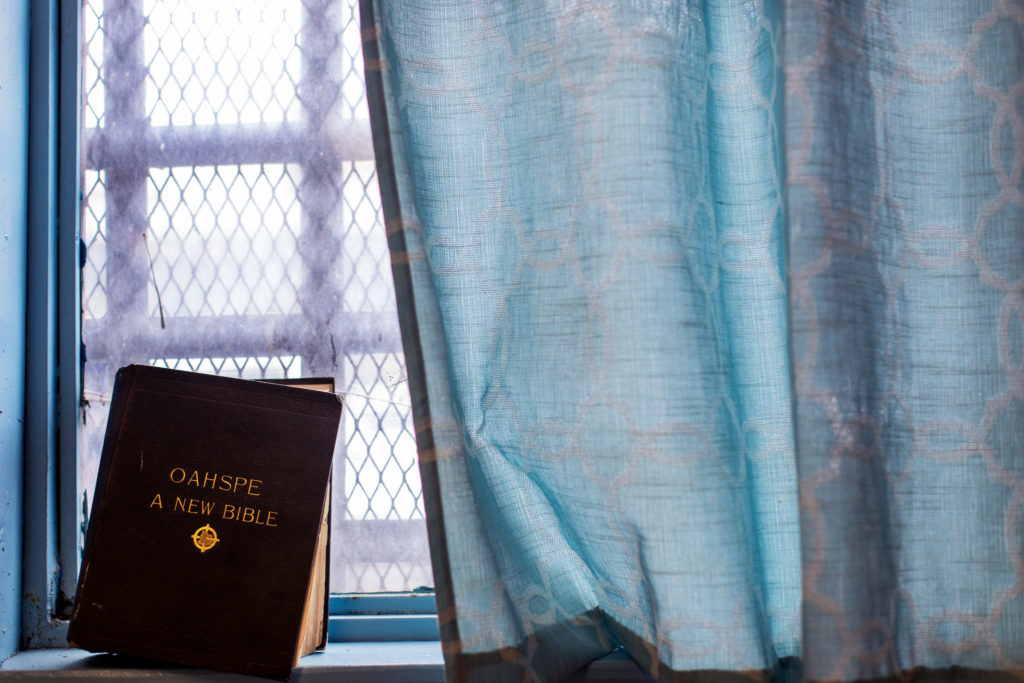
The Oahspe bible, a mystical document said to be the divine inspiration of Dr. John Newbrough, a 19th-century Manhattan dentist.CreditDemetrius Freeman for The New York Times
Or maybe you’d like to read about a new religion? How do you feel about the blockchain? It’s pretty clear what Drew Millard thinks. He exclaims (and then explains) Oh God, they’re putting religion on the blockchain at The Outline
Faith is about the only thing driving the cryptocurrency industry, which goes a long way towards explaining 0xΩ, a “blockchain religion” created by artist Avery Singer and Matt Liston, the ex-CEO of decentralized prediction market platform Augur. While the details of 0xΩ are a bit fuzzy, it’s basically meant as a platform where people can democratically design a belief system and use blockchain technology to exchange “sacred texts” and vote on the operations of said religion.
Okay, maybe it’s time to listen to something? We recommend Faye Ginsburg‘s appearance on the podcast Online Gods
And with that, we’re going to leave you for the summer. Be well, read well, and fight hard. We’ll see you in September!
